
Stigmella progama is a species of moth in the family Nepticulidae. This species is endemic to New Zealand. It is classified as "Data Deficient" by the Department of Conservation. S. progama has only been collected on Bold Peak in Otago.
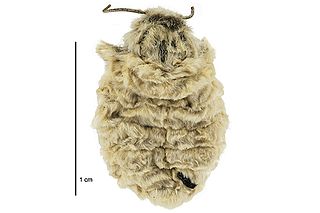
Metacrias huttoni is a species of moth in the family Erebidae. This species is endemic to New Zealand where it is known from the eastern areas of the South Island. The female of the species is flightless and buff coloured where as the male is brightly coloured and flies during the day.
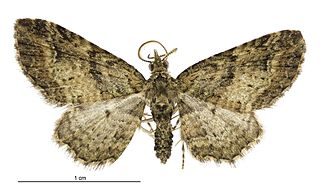
Pasiphila charybdis is a species of moth in the family Geometridae. It is endemic to New Zealand.

Ichneutica blenheimensis is a species of moth in the family Noctuidae. It is endemic to New Zealand and is found throughout the North, South and the Stewart Islands. This species appears to prefer drier eastern localities and is rarely collected in western North Island forested areas. It does not appear to be frequently collected in inland dry tussock grassland habitats. The host plant for the larvae of this species is likely to be the golden sand sedge pīngao which is now absent from the moths type locality. However Chappell has raised very young larvae on grass species and the more developed larvae consumed Phormium tenax. Adults are on the wing from November to March and are attracted to both light and sugar traps. The blackish forewing fringes are diagnostic of this species. But worn specimens of I. arotis can be confused with worn specimens of I. blenheimensis. However I. arotis can be distinguished from I. blenheimensis as it has a scale-tuft on the thorax and dark longitudinal stripes on the tegula. This species is classified as "At Risk, Naturally Uncommon" by the Department of Conservation.
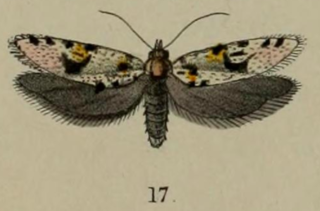
Eurythecta robusta is a species of moth in the family Tortricidae. This species is endemic to New Zealand. It is classified as "At Risk, Naturally Uncommon" by the Department of Conservation.
Kiwaia pumila is a moth in the family Gelechiidae. It is endemic to New Zealand. It is classified as Nationally Vulnerable by the Department of Conservation.

Pseudocoremia fluminea is a species of moth in the family Geometridae. It is endemic to New Zealand. It is classified as Not Threatened by the Department of Conservation.

Arctesthes catapyrrha is a moth of the family Geometridae. It is endemic to New Zealand.

Asaphodes beata is a species of moth in the family Geometridae. It is endemic to New Zealand and is a relatively common species that can be found throughout the country in native forest or scrub habitat. It can be distinguished from its close relative Asaphodes adonis by the colour of its hind wings. The larvae of this species feeds on watercress but tends to be inactive during the day. If threatened it will mimic a twig dropping to the ground. The adult moths are on the wing from October to March and are said to be attracted to white rātā. The white markings on the forewing of the adults are variable in appearance.

Austramathes purpurea is a species of moth in the family Noctuidae. It is endemic to New Zealand and can be found throughout the North and South Islands but has yet to be recorded at Stewart Island. It inhabits native forest. This species might possibly be confused with A. pessota, however this latter species does not have the purple hue to the forewings. The larvae of A. purpurea feed primarily on māhoe but have been recorded as feeding on, and have been reared on, narrow-leaved māhoe. The larvae pupate in a silken cocoon on moss covered ground. Adults can be found on the wing during the months of March to January but mainly occur during New Zealand's late autumn, winter, and spring. Light trapping may not be the most efficient technique for collecting this species.
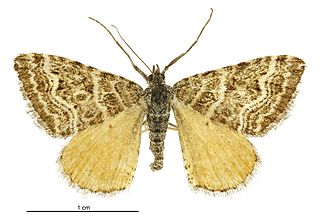
Xanthorhoe bulbulata is a species of moth in the family Geometridae. It is endemic to New Zealand. It is classified as critically endangered by the Department of Conservation.

Samana acutata is a species of moth in the family Geometridae This species is endemic to New Zealand. It is classified as "At Risk, Relict" by the Department of Conservation.

Austrocidaria lithurga is a species of moth in the family Geometridae. It is endemic to New Zealand. This moth is classified as at risk, naturally uncommon by the Department of Conservation.

Dasyuris enysii is a species of moth in the family Geometridae. It is endemic to New Zealand. This moth is classified as "At Risk, Naturally Uncommon" by the Department of Conservation.

Xanthorhoe lophogramma is a species of moth in the family Geometridae. It is endemic to New Zealand. It is classified as "At Risk, Nationally Uncommon" by the Department of Conservation.

Euxoa ceropachoides, commonly known as Fereday's cutworm, is a species of moth in the family Noctuidae. It is endemic to New Zealand. It is classified as Not Threatened by the Department of Conservation.
Leptocroca xyrias is a species of moth in the family Oecophoridae. The taxonomy of this species is in need of revision and L. xyrias likely belongs to a separate genus. It is endemic to New Zealand. It has been classified as Data Deficient by the Department of Conservation.

Austrocidaria anguligera is a species of moth in the family Geometridae. It is endemic to New Zealand. It is regarded as being uncommon but is frequently confused with Austrocidaria bipartita.

Asaphodes cosmodora is a species of moth in the family Geometridae. This species is endemic to New Zealand and has been observed in the South Island. The adults of this species are on the wing in January and February.
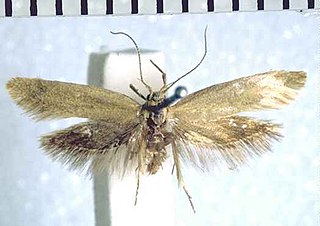
Tingena paula is a species of moth in the family Oecophoridae. It is endemic to New Zealand and has been observed in Canterbury. Adults of this species are on the wing in November.




















